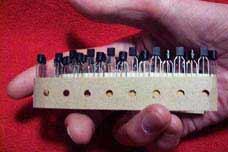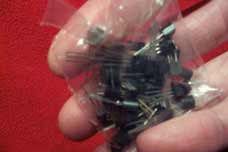SILICON. I've designed the circuits for silicon transistors. Germanium, gallium arsenide, and other semiconductor materials require different bias resistor values. I'll leave the circuit changes up to you. (Maybe a gallium arsenide FET will turn up in some future project. I haven't found a need for one yet.)
I prefer through-hole devices to surface mount, but the two types are equivalent. If you have very small, nimble fingers, you can experiment with surface mount.
THE TABLE BELOW provides several equivalent device types. You can purchase such devices at hamfests or from first-line or surplus vendors. Some "house" type transistors will also work. Just be sure that you're using silicon devices with a gain (beta or hfe) of 200. You can find out the beta by testing the device. Testing is superior to a spec sheet lookup. The spec sheet usually states a range. But you want the beta for the device in your hand. Time to test!
Equivalent Transistor Table
| NPN Transistor | PNP Transistor | N-Channel JFET | |
| 2N2222 | 108 | 2N3906 | MPF102 |
| 2N3904 | 109 | 2N2907 | 2N3822 |
| 2N4401 | MPS2369 | MPS3638A | 2N5458 |
| PN2222A | MPS3704 | MPS6534 | BF244A |
| NTE123AP | MPSA20 | 159 | BF245A |
| 2N4400 | 276-2009 | MPS8699 | J113 |
| 2N5772 | 2SC45 | BC179 | J210 |
| 107 | BC180B | 2SB808 | NTE457 |
Note: Check pinout of replacement part.
Part Grades
You can buy several grades of parts. I've already mentioned a few. Below, I describe the common grades in detail...
END-RUN PARTS. Sometimes we call these "tape and reel" parts. Vendors often sell these devices on strips of cardboard. Tape holds the transistors to the cardboard. If you're wealthy, you can buy a "reel" with the cardboard strip wrapped around it. A reel might contain thousands of transistors. You'll be set for life! The reels are what remains of a factory production run. In the factory, one or more reels feed pick-and-place machines that stuff circuit boards.
HOUSE-NUMBER PARTS are a bit more expensive than off-spec parts. But within a type number, house number parts tend to operate uniformly. You won't be able to check a datasheet, because house parts have no accessible reference sheet. By testing a few samples, you might discover that your house part works just like something you have a data sheet for. If you got a good price, that's great.
PULLOUT PARTS are used. Usually the term "pullout" applies to tubes, relays, modules, meters or power capacitors. Most catalog houses and Web vendors sell new semiconductors. Pullout transistors turn up at hamfests. Pullouts might be a valid way to acquire exotic devices. For example, an old circuit project might call for a low-gain device. Buying a pullout transistor might be the only way to make the circuit work. Otherwise, you don't need to buy a used part. New semiconductors are common. On the other hand, the used price is right. Besides, pullouts can be more reliable and uniform than off-spec parts. Before you build with used parts, be sure to test them.
OFF-SPEC PARTS (usually with no package ID) sell at "bargain bag" prices. These parts are dropouts from a factory production run. Along with the bargain bag comes a serious cost: You'll have to sort your treasures, because device performance varies wildly.
RETAIL PARTS. You can go to a storefront and buy new or surplus parts. The walkup convenience factor costs you, though. Instead of paying a nickel to 20 cents per device, you might pay a buck. If you're buying "bargain bag," off-spec devices, the deal is even worse. For the same price, a major Web vendor will sell you new, brand-name devices. Retail's strongest advantage is convenience. If you need something now, then nobody beats retail. Retail also makes possible easy merchandise returns or exchanges. Otherwise, the Web and the delivery service are your friends. Don't forget to factor delivery charges into your cost.
WEB AND CATALOG PARTS. Web vendors are giving walkup retail a run for the money. That's only fair. The markup for some retail parts might be 100 to 1 or more. Also, retail has had the market to itself for a long time. It could compete, but the creativity isn't there anymore. Plainly, somebody's asleep at the switch.
On the Web, nobody cares if you're a mechanical TV geek. Buy what you want, and pay the down-to-earth price. Tired of back-ordering from the walkup store? Web stores stock tens of thousands of items. The selection is fabulous, and you can choose whether to buy new or surplus. You never have to drive downtown, and comparison shopping couldn't be easier. Don't buy anything heavy though, or the shipping tab wrecks all your fun!
EBAY ELECTRONICS COMPONENTS are part of the Web flea market. But eBay is in a class by itself. Chinese vendors compete with locals for best quality, delivery speed, and lowest shipping price. New-old stock and obsolete parts are available again, often at bargain prices. Even Walmart and Sears sell electronic components, such as miniature speakers and semiconductors! Overall, the prices are typically below wholesale. The only way to beat these prices would be to buy in lots. Click:
| End-run parts may contain a brand name and searchable part number. Or you might receive a strip of house parts. Either way, the parts cost more than off-spec parts. As you'd expect, within a part number, the quality tends to be more uniform. Watch the price, though. Large catalog houses sell new parts for close to the surplus price. |

|
| Some transistors may have the leads wired backwards. Many in your group won't work at all. You might find other devices with amazingly high gains. Not bad for a one-transistor project that you never need to duplicate. But what if you need to service your project? If the transistor blows, you can't match it with any other device. Because of the non-uniformity, I usually avoid off-spec parts. |

|
